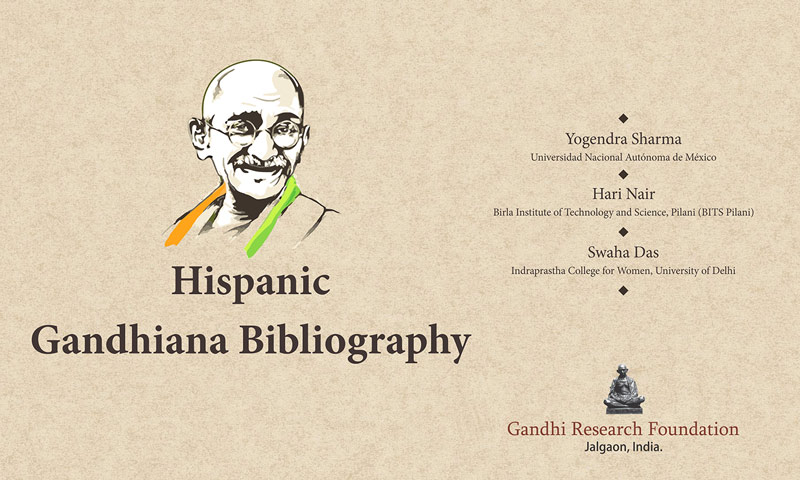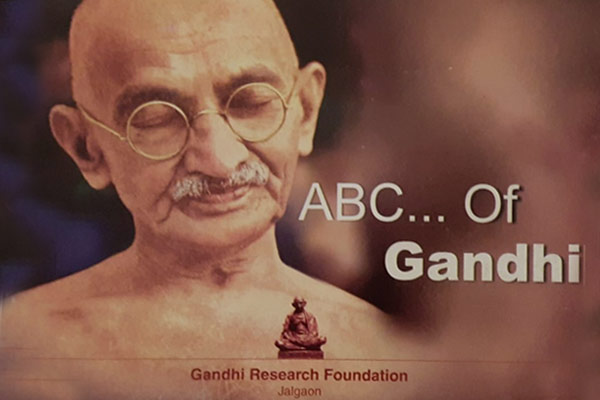 Hispanic Gandhiana Bibliography: Published in 2021, Yogendra Sharma, Hari Nair and Swaha Das (co-authors) Gandhi Research Foundation, Jalgaon (research sponsor and publisher). Hispanic Gandhiana Bibliography (2021) is a bi-lingual Spanish-English bibliography on
Mahatma Gandhi. It contains a list of books published in Spanish between circa 1924 and 2020. The bibliography has approximately six hundred references and contains a prefatory note. It is accompanied by an index of dates, keywords, names of persons, and places. Although the list is primarily focused on books, it also includes references to archival material; articles in journals, magazines, and newspapers; audio recordings; braille texts; comics; manuscripts; music; music for movies; musical
notations; newspaper clippings; posters; songs; university dissertations/theses; and videos. The bibliography is clustered chronologically into decades, and within each decade, the list has been divided into two thematic sections: works by Gandhi and works on Gandhi. This bibliography was an outcome of a research project funded by the Gandhi Research Foundation, Jalgaon (India) between September 2020 and March 2021. The Hispanic Gandhiana Bibliography was prepared as a preliminary step
for understanding how the Hispanic world engaged with Gandhi.This work will be useful to scholars of Gandhi Studies and Contemporary India.
eBook Available in PDF Please Contact us:
Tel.: +91 (0)257-2264 803, +91 (0)257-2260 033;
Email: info@gandhifoundation.net
 ABC of Gandhi: Published in 2008 and edited by Professor Narendra Sharma. The book is unique in its content and format, as Gandhiji’s ideals have been compiled in alphabetical order.
Gandhi Ganga: Published in 2008 and edited by Dr. M.B. Shah. The book is a collection of articles written by Gandhiji and his close associates like Acharya Vinoba Bhave, Millie Graham Polak, Kaka Kalelkar, Umashankar Joshi, Ghanshyam Das Birla, etc.
Aapale Gandhi: Published in 2009 and was translated in Marathi by Dr. M.B. Shah and Dr. Vishwas Patil. The title and essence of the book is ‘Our Gandhi’. It was originally written by a Gandhian scholar, Narayanbhai Desai, in Gujarati.
Sadhak Gandhi: Published in 2011, authored by Dr. Vishwas Patil. It portrays the contemplative and spiritual profile of Gandhiji’s persona.
Satyagrahi Gandhi: Published in 2011, and written by Dr. Vishwas Patil. True to its name, the theme and objective of the book is to highlight the Satyagraha (passive resistance) concept of Gandhiji and how he used it as an effective tool in his various struggles, beginning in South Africa and then taking root in the Indian Freedom struggle.
Samarpit Gandhi: Published in 2011 and written by Dr. Vishwas Patil. It portrays the undying dedication and commitment of the Mahatma towards his country and his countrymen.
M.G. Sant Sangati I: Published in 2012, and written by Dr. Vishwas Patil. This is an innovative work depicting the lives of like-minded associates of Gandhiji. One can say that they were the pious, spiritual companions of Gandhiji who shared and drew from his chaste and frugal life.
Gandhi Katha: One of Narayanbhai Desai’s major contributions to society is the Gandhi Katha or the life story of Gandhiji, told live from a dais. It is developed in a lyrical story-telling style and has become very popular for its simple yet effective manner of connecting with the masses. The GRF has undertaken the Hindi translation of this story in a book form. The compiling and editing was done by Dr. Yogendra Yadav.
Hruadhayachi Falnee: Published in 2017, written by Narayanbhai Desai in Gujarati ‘Jigarna Chira’, translated into Marathi by Dr. Vishwas Patil. In this book the author has focused on the Partition of the Subcontinent and has also clarified some misconceptions about Gandhiji.
Kaljayee Gandhiji: Published in 2017, written by Narayan Desai, and translated into Marathi by Dr. Vishwas Patil. The book gives insights into Gandhiji’s Satyagraha and other related issues.
M.G. Sant Sangati II: Vol. - 2: Published in 2011 and written by Dr. Vishwas Patil. It portrays the undying dedication and commitment of the Mahatma towards his country and his countrymen.
Gandhi on Health: This book shows that Gandhi intended, 100 years ago, to become a professional British-trained M.D., that after abandoning that idea and criticizing Western medicine he practiced amateur healing for the rest of his life (sometimes with notable success), that he admired some Western-type doctors and would sometimes discard his own dogmas about health care, that he practiced palliative care (for Kasturba) and euthanasia(!), and that he foresaw that the right to subsidized health care could be maintained only if the people perform their corresponding duty of taking good care of themselves in terms of exercise, weight, hygiene etc.
Kasturi Gandh: A biographical sketch of Kasturba Gandhi: an unlettered woman who was witness to some of the greatest times and happenings of modern Indian history by being an active contributor to the life of its chief architect.
Her life had the thrill of a small town woman migrating across ocean to have a cross cultural cohabitation, sufferings of a social outcaste and the struggle of a rebel; getting lynched and jail terms were part of her normal routine.
She was an emotional mother, passionate wife, self–empowered self; yet Kasturba rose above all these bounds to be a matriarch of a cosmopolitan community in her ashram in particular and her nation family at large.
Her critical enquiry into Gandhi’s position helped the latter retune his thought and action. In that sense she was an instrument in the making of the Mahatma.
Those came in contact with her instantly experienced the purity of her heart and simplicity; those associated with her for long understood the steely heart and unbreakable resolve that led her to supreme sacrifice for the cause of human family. That is why Gandhiji called her ‘Jagadamba’.
This lucid book is worth reading as the life of the protagonist is filled with insightful realism for the new generation to pick up.
|